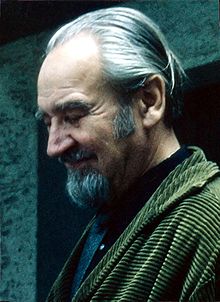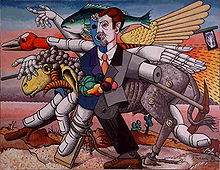Helmut Thoma (painter)
Helmut Thoma (born August 17, 1909 in Lugnian , Upper Silesia, † September 10, 1993 in Berlin ) was a German painter and art teacher .
Life
Helmut Thoma studied from 1930 to 1934 at the Breslau Academy of Arts and Crafts with Oskar Moll and in Berlin at the State Art School Berlin-Schöneberg with Georg Tappert , Curt Lahs and Konrad von Kardorff . Here he also met his friend, the painter Gerhard Fietz , who later also held a professorship at the State University of Fine Arts in Berlin.
From 1935 to 1940 he worked as an art teacher at higher schools in Berlin. During this time he lived with his first wife, the painter Marion Weiss, at Spichernstrasse 16 in a studio apartment in which Helene Weigel and later Bertolt Brecht had lived.
After serving in the war and being imprisoned by the Soviets, he returned to Berlin in 1948 and met his second wife, Cornelia, who had been a close friend of Marion Weiss and who had accompanied her during her cancer illness.
In 1948 he began teaching painting and drawing in the art education department of the State University of Fine Arts Berlin, today Berlin University of the Arts . He has held a professorship there since 1950. From 1958 to 1965 he was also head of the art education department. In 1974 he was retired.
painting
In Helmut Thomas painting there are 5 phases.
Phase I: 1930-1940
This first phase of his work is determined by the joy of the visible world. During these years, when he was studying and doing his legal clerkship, he met the Breslau academy teachers Otto Müller , Paul Holz and Oskar Moll . He sees himself as part of the circles of these painters. Many charcoal drawings are made. Portraits, still lifes, interiors and landscapes are motifs of this phase. The starting point of his pictures is always nature, which he enriches with his own feelings in order to increase expression. While working as a teacher, he continues to paint. The exhibition “ Degenerate Art ”, which took place in Berlin in 1939, made a big impression on Thoma and prompted him to rethink his previous style of painting. “My positive attitude towards the world and my belief that the visual image is sufficient as a subject for the painter was finished.” Only a few works have survived from this period.
Phase II: 1948-1957
The second phase of his work begins with his return home from Soviet captivity. His main interest is now the domestic and foreign art that was created during the war years. He is particularly interested in Picasso , Georges Braque , Paul Klee and Max Ernst . His painting begins to move away from the visual image. The first tentative attempts in terms of dealing with Cubism take place. He experiences the environment in fragments, the objects in his pictures are dismantled, divided up and intertwined. He also creates a series of mostly small-format paintings in which fantasy figures are strangely interwoven in a network of symbols. The end of this period marks the bulky interlocking rods that form romantic-technoid landscapes and provide a glimpse into the dream world of an irrational industry.
Phase III: 1957-1964
The third phase is characterized by the loosening of the painting style. The pictures of this time were created emotionally and impulsively out of a patch of color. Graphic elements eventually become independent brush strokes, although Thoma never, as he later realizes, loses the connection to nature. His landscapes are reminiscent of Japanese calligraphy ( Shodō ), in which he works with the contrast of light and dark and lets the movements and currents inherent in the image speak for themselves. He was inspired by the island of Cres , which he visited for the first time and which became important for his work. At the end of this phase, in addition to the watercolors “playing” with landscapes, he also created clear images of women's bodies. “What has actually remained constant in my painting since 1930? The recurring tendency towards the human figure, the landscape and the still life! "
Phase IV: 1964-1984
The paintings created in this fourth phase were based on collages, which Thoma produced exclusively from black and white photographs. So they are painted collages in which limbs in unusual proportions interlock, stack, tower and thus form idiosyncratic sculptures. Initially without a background, they are later embedded in a landscape. 1966–1979 the human head disappears from the works of Helmut Thomas, from 1974 it can be suspected again, hidden behind phalanxes, in “Still Life with the Sick Painter” (February 1979) it gets its face back. The main motifs of the paintings until the end of the 1970s are fruits, vegetables, flowers and animals. The works from 1980–1984 seem like potpourris trying to capture the average citizen - or intellectual - on canvas in the late 20th century. This is how “landscapes of the soul” are created. The work ranges from small to very large pictures in oil, acrylic and Aquatec, from delicate watercolors to strong charcoal drawings.
Phase V: 1984-1993
In Thomas' late work, the head again plays an important role. “However, these pictures are not portraits, they rather try to show the diversity of the individual without referring to a specific person.” Here Thoma plays with the styles of Cubism , Expressionism and Tachism . First he continued his series “Contemporary Pictures” and created several important self-portraits (for example “Rochus Himself Behind Shards”, 1989). Since his strength was waning, from 1987 onwards he created many small-format pictures, the “rag pictures”. He places his work on scraps of clothing and cloth. Broken heads come to light again: the "reverse head", the "cross head" and the "split head". Other heads are chopped up, cut vertically, horizontally, or criss-cross and have holes in them. Thoma now expresses in one face what he previously represented through the combination of several heads: disruption, destruction, loss (or search for) identity. In addition to the rag pictures, he creates charcoal and colored works in which wires, objects and patterns partially overlay and cover the head.
In the last phase of his artistic work, Helmut Thoma combined many different styles. Here is a quote from his autobiography:
“I had in mind to combine different types of design and styles, all of which can be described as different degrees of abstraction, in one picture. Realistic, tachistic, impressionistic, expressionistic, cubistic, perhaps also kitschy, commercial graphic and any other elements could be used in a picture, whereby I hoped that the quantity of dissonances between the accumulated artistic possibilities of expression would lead to a new quality of unity. "
From 1955 to 1981 his painting was influenced by regular stays on the island of Cres , from 1981 on the island of Tenerife .
Exhibitions
- Helmut Thoma - Works from 1966 and 1967 (Galerie Hammer in the Europacenter, Berlin, October 1 - October 31, 1967)
- Helmut Thoma - pictures, drawings, linocuts from the years 1966 to 1968 (Kunstkabinett am Steintor, Hanover, February 25 - March 23, 1968)
- Helmut Thoma - retrospective exhibition - works from the years 1934 to 1968 ( Kunsthalle Wilhelmshaven , June 1 - 22, 1969)
- Helmut Thoma - The many-faced contemporaries - picture-water-color-collage-drawings from the years 1980-85 (Kunstamt Reinickendorf, Berlin, October 6th - September 26th 1985)
- Helmut Thoma - Pictures, "Lumpenbilder" and works on paper from 1986–89 ( Haus am Lützowplatz , Berlin, August 10th - September 3rd, 1989)
- Helmut Thoma and Gerhard Fietz - Two Silesian painters in Berlin , ( Ostdeutsche Galerie Regensburg 1963)
- Helmut Thoma - Pictures and drawings from the years 1964 to 1979 ( Haus am Lützowplatz , Berlin, February 9 - March 9, 1980)
- My life - a collage - a retrospective of the work of Helmut Thomas (1909–1993) , (SORAT Hotel Spree-Bogen, Alt Moabit 99, January 26, 1998 - March 22, 1998)
- Helmut Thoma and Gerhard Fietz , (Fietz-Haus fietz-haus.de , Bleckede 2001)
Museums
The following museums own works by Helmut Thoma:
- Berlinische Galerie
- Wilhelmshaven art gallery
- Sudeten German Gallery in Regensburg
Helmut Thoma Foundation
Helmut Thoma bequeathed his work to the Berlin University of the Arts. Since 1996, students of the field of fine arts have been sponsored with the Helmut Thoma Prize endowed with 3,100 euros from the proceeds of the pictures sold .
literature
- Helmut Thoma: My life - a collage. Autobiographical writings by Helmut Thoma. University of the Arts, Berlin 1991, ISBN 3-89462-005-6 .
- Helmut Thoma: Catalog raisonné of the collages 1953-1970, on the occasion of the exhibition in the gallery in the Schinkelsaal (February 20 to March 17, 1972). Text by Hubertus Lossow . Reinickendorf Art Office, Berlin 1972.
- Helmut Thoma: Pictures, “Lumpenbilder” and works on paper from 1986–89. Exhibition in the house on Lützowplatz, 10.8. - 3.9.1989 / Event: Fördererkreis Kulturzentrum Berlin e. V.
- Helmut Thoma: The many-faced contemporaries. Pictures, watercolors, collages, drawings from the years 1980–85. Exhibition from October 6th - 26.11.1985 in the Rathaus-Galerie Berlin-Wittenau / Rathaus-Galerie Reinickendorf. [Event u. Ed. D. Catalogs district office Reinickendorf of Berlin, department of public education, art office. Catalog ed. u. Exhibition director Georg Pinagel. Graphothek Berlin]
- Helmut Thoma: Pictures and drawings from the years 1964–1979. Exhibition in Haus am Lützowplatz, Berlin / Event: Fördererkreis Kulturzentrum Berlin e. V.
- Helmut Thoma. In: Axel-Alexander Ziese (Ed.): General lexicon of artists in the visual and creative arts of the late 20th century. Jean Gebser Academy, Bad Schmiedeberg 2005, ISBN 3-923326-75-0 .
Web links
- Literature by and about Helmut Thoma in the catalog of the German National Library
- Homepage of the Helmut Thoma Foundation - with pictures by the artist Helmut Thoma from 5 phases and excerpts from his book My Life - A Collage
- Vernissage on November 22nd, 2018 at the Berlin University of the Arts
- More pictures in the picture gallery
- On the trail of modernity. Life and work of Helmut Thomas: A collage . Lecture by Prof. Dr. Otfried Scholz from October 15, 2008 in the Charité (UdK) lecture series: "Arts ... (PDF; 38.4 kB)
Individual evidence
- ↑ Helmut Thoma: My life. P. 77. See also helmut-thoma-stiftung.de
| personal data | |
|---|---|
| SURNAME | Thoma, Helmut |
| BRIEF DESCRIPTION | German painter |
| DATE OF BIRTH | 17th August 1909 |
| PLACE OF BIRTH | Lugnian |
| DATE OF DEATH | September 10, 1993 |
| Place of death | Berlin |





